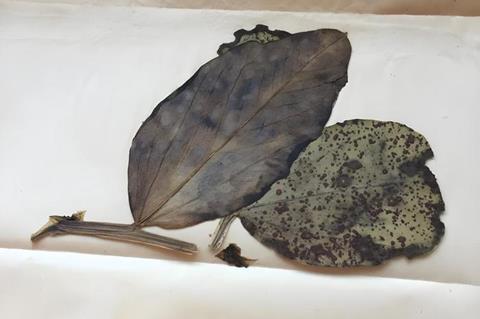In a significant scientific milestone, researchers at the Hebrew University of Jerusalem have successfully revived fungal specimens collected over 80 years ago, offering an fresh glimpse into how industrial agriculture has altered the invisible ecosystems that support global food production.

The study, published at iScience was led by Dr. Dagan Sade under the supervision of Professor Gila Kahila of the Robert H. Smith Faculty of Agriculture, Food and Environment in collaboration with colleagues from the Hebrew University, Tel Aviv University, Ben-Gurion University and the Ministry of Agriculture and Rural Development.
READ MORE: Fungal protein yields new ways to modulate cell activity remotely
READ MORE: Fungal foe fended off: DNA demethylation boosts tomato resistance
It focused on Botrytis cinerea, a widespread plant pathogen responsible for gray mold disease in over 200 crop species. This fungus poses a significant threat to agriculture, resulting in billions of dollars in annual losses and presenting challenges to food security, trade, and environmental health.
Before the Green Revolution
But what happens when we revive fungi from an era before synthetic fertilizers and fungicides, before the Green Revolution fundamentally transformed how we grow food?
To find out, the team revived two strains of Botrytis cinerea curated at the National Natural History Collection of the Hebrew University since the early 1940s—decades before modern agrochemicals became standard in farming. These historical specimens were carefully reanimated and subjected to cutting-edge analyses, including whole-genome sequencing, transcriptomics (gene expression profiling), and metabolomics (chemical fingerprinting).
Striking differences
The findings were striking: the historical strains showed significant genetic and behavioral differences compared to modern lab strains of the same fungus. In particular, they revealed:
- Reduced signs of fungicide resistance, a feature that has become prominent in modern strains due to heavy chemical use;
- Differences in pathogenicity, with some traits suggesting the historical fungi were less specialized and aggressive than their contemporary counterparts;
- Adaptations to different environmental conditions, including pH tolerance and host specificity.
“These fungi have been quietly evolving in response to everything we’ve done in agriculture over the past 80 years,” said the researchers. “By comparing ancient and modern strains, we can measure the biological cost of human intervention—and learn how to do better.”
Window into the agricultural past
The research has wide-ranging implications. In the era of climate change, pesticide overuse, and declining soil health, understanding how plant pathogens adapt to human activity is key to developing sustainable farming systems. Reviving historical microorganisms provides a baseline for this understanding—a way to distinguish between natural evolutionary changes and those driven by anthropogenic pressures.
“Natural history collections have always been valuable for taxonomy and museum science,” said the researchers. “But this work shows they are also dynamic resources for modern biology. They allow us to ‘rewind’ microbial evolution and anticipate future trends in plant disease.”
The study also contributes to global efforts to predict and manage plant disease outbreaks. By revealing how pathogens adapted to previous environmental shifts, scientists can better model future risks and design resilient crop protection strategies—potentially reducing reliance on chemical treatments that harm ecosystems and accelerate resistance.
Reviving more than specimens
The success of this project speaks to a broader scientific movement: turning biological archives into tools for addressing 21st-century challenges. Whether it’s climate change, antibiotic resistance, or declining biodiversity, many of today’s most pressing problems require historical context to solve.
“This work is a perfect example of how past and future can intersect through science,” said the researchers. “We brought something back to life not for nostalgia, but to help build a more sustainable agricultural system.”
The project was conducted in collaboration with genomic, microbiology, and metabolomics experts. The team hopes the findings will encourage other institutions to reassess the hidden power of their biological collections—and push for more interdisciplinary approaches to solving global food and environmental crises.
Topics
- Agriculture
- Antimicrobial Resistance
- Ben-Gurion University
- Botrytis cinerea
- Dagan Sade
- Food Security
- Fungi
- Gila Kahila
- Healthy Land
- Hebrew University of Jerusalem
- Metabolomics
- Middle East & Africa
- Ministry of Agriculture and Rural Development
- Research News
- Soil & Plant Science
- Tel Aviv University
- Transcriptomics
- Whole genome sequencing







No comments yet